On form and energy in composition
Introduction: Conceptual Background
Dozens of silvery, threadlike lines supporting one another; energies across spectra and forms all interlinked and state-changing in what seems to be a chaotic, yet utterly controlled, order.
- N. K. Jemisin
For quite a few years I have considered (at least in some of my pieces) a concept that I called ‘polyphony of form’ or ‘formal polyphony’, though in retrospect it is probably better called ‘polyformalism’ or ‘polyformal music’. Perhaps more accurately, if also more linguistically awkwards: multi-parametric-form. This concept arose out of my interest in and adaptation of the techniques of composers such as Karlheinz Stockhausen, Olivier Messiaen, and an interpretation of the music of Brian Ferneyhough, along with the experimental processes of composers like John Cage. The concept (or technique) is such that one can have macro, meso, and micro (along with super-macro etc.) forms applied to individual musical parameters across a whole composition. In my work, this was mostly applied based on Messiaen’s approaches of decoupling, for example, two parameters such as pitch and rhythm, iterating them separately with separate cyclic durations. The result of such operations is a larger structure that emerges from small ones. Across a whole composition, then, one can pre-compose structures that give rise to the surface of the piece. An example of this is in my 2017 piece ‘a process, delicate and violent’ for alto flute, which has a simple structure of a repeating ABAB… etc. pattern of what I would now call musical containers, but at that time just considered to be a unit of time. So from that a form emerges based on that parameter. The realisation of that was that each bar alternated between a ’notated’ gesture and a ’tablature’ gesture (of sorts). The second layer was an arch form of ‘density’ applied only to the A material, mirrored roughly in the middle of the piece. So it starts with tacet for n measures, then starts to build towards an A-material climactic middle and again taper off at the end resulting in tacet again. These two ideas produce an overlapping form, where the surface of the piece is modified by not one but two (actually, more, but for now, two) formal structures, or, a polyform. I like the term polyform as a portmanteau of polyphony of form. It also resonates loosely with this (from Wikipedia):
In recreational mathematics, a polyform is a plane figure or solid compound constructed by joining together identical basic polygons. The basic polygon is often (but not necessarily) a convex plane-filling polygon, such as a square or a triangle. More specific names have been given to polyforms resulting from specific basic polygons, as detailed in the table below. For example, a square basic polygon results in the well-known polyominoes.
Construction rules The rules for joining the polygons together may vary, and must therefore be stated for each distinct type of polyform. Generally, however, the following rules apply:
Two basic polygons may be joined only along a common edge, and must share the entirety of that edge.
No two basic polygons may overlap.
A polyform must be connected (that is, all one piece; see connected graph, connected space). Configurations of disconnected basic polygons do not qualify as polyforms.
The mirror image of an asymmetric polyform is not considered a distinct polyform (polyforms are “double sided”).
The analogy only goes so far, but nonetheless, I think there is a referential relationship. If one were to view the surface of a piece of music outside of time (and I mean this in the abstract sense of say, a 4D creature able to perceive time as its own dimension rather than existing within it) then one might not be able to see the basic building-blocks of the piece, but rather, that their impact on the surface, which would appear, presumably, as a static object. Modifications to that underlying structure - the constituent parts of the polyform - would presumably yield a different, albeit static, texture, in the same form at the scale of the object.
There are additional layers in that piece that are basically random distributions, that indicate the duration of each B-material, the quantity of finger positions in each B position, and so on. This adds a mapping of formal structures against the B materials. This view then can think about the piece as two sets of material - a kind of “intuitively” composed set of A materials, in an arch form, interlocked with another set of materials that are the result of lower-level chance operations resulting in indeterminacy in those materials at the point of composition, but once fixed, the material becomes determinate. The neat thing is that because the piece is 9 minutes long, and that largest container is fixed, changing variables or re-iterating the distributions internally would reduce in the same interlocked A/B structure but with quite radically different internal and surface-level morphologies.
Against this is an intuitively added ’lip roll position’ staff that changes over the course of the piece, regardless of whether it is an A or B material container. And so, the ‘polyform’ emerges from these underlying parts. The other way that I liked to think about it was that of a structure/form split - you see the form, like a building, as a whole, but the internal structure that holds it together, and gives rise to it is rendered invisible by the surface of the object. At the time, asides the aforementioned composer, this thinking was off the back of a lot of interest and investigation into emergent properties in nature. Most notably genes and emergent phenotypes (and related/analogous cultural phenomena), and while the analogy falls apart in many ways, it is still useful to think of the emergent form from underlying structures.
Present Conceptualisation
In the last couple of months, after a period of relative inactivity, I’ve been trying to figure out aspects of my practice, reinvigorate it, and also consolidate my conceptual thinking about a lot of areas of music. The relationship between material and form, along with the potential conflict between generative (read algorithmic) work and more ‘intuitive’ work (a fairly silly dichotomy, really, but nonetheless part of my thinking). On the advice from Evan Johnson, whom I had some lessons/meetings/mentoring with, I’ve been looking again at the writings and work of Brian Ferneyhough1, and of others about him (such as Richard Toop2 3), and have been struck by his writing on what he calls lines of force. I’m going to paraphrase from primarily the Collected Writings of Brian Ferneyhough1, mostly for my own consolidation of understanding and definition, but also to examine how to map the concept to my existing models of composition. A lot of this thinking has already been applied retrospectively, as above with the ‘out of time’ view on a work, for example. Ferneyhough doesn’t explicitly say this, but I got that sense from an analogy of waves whereby there is a sense of movement but actually from a given framing, the wave is static, and you’re experiencing the surface level affect of subcutaneous processes. For Ferneyhough, the lines of force of a composition are one part of the expressive potential; certain potential energies being accumulated and released with the intersections of these lines of force. I do think that for Ferneyhough, a part of these lines of force is akin to what I described above, but I think I was missing a crucial, lower-level component for the creation of energy at a localised level that then has impact at larger and larger scales. Put another way, where my structural thinking, as described above, gave rise to a large surface, the intersection of those structures is not necessarily apparent in as direct a way. It’s more like variables that are being adjusted, yielding a different surface, rather than energies combining and dissolving, and feeding back into the system. Indeed, I think it is this feedback process that has been missing in my work.
Trying to describe this with language will be a bit clumsy, however a useful analogy may be a wave form. Noting that the following analogy is really seeing things at the surface, but with adjusted subcutaneous parameters that create intersections between the various lines of force. If we start with a simple sinusoidal wave form:
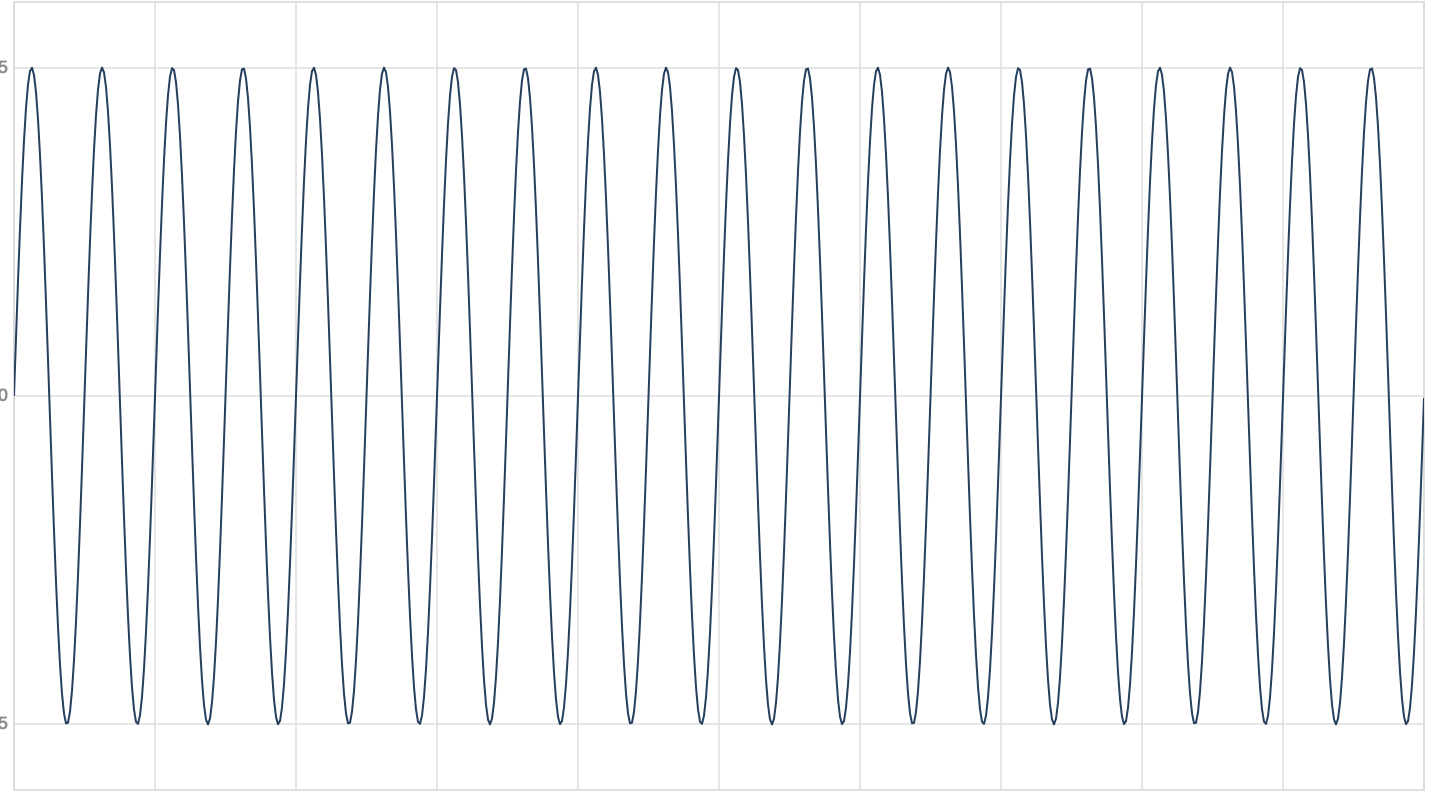
Now, if we apply an additional line of force (or process) to this wave form, specifically affecting the amplitude of the wave form in time, but periodically, we get the following (an enveloped wave form):

And finally, to demonstrate the underpinning flow, if I add a degree of variable randomness and an additional line of force, we get the following:
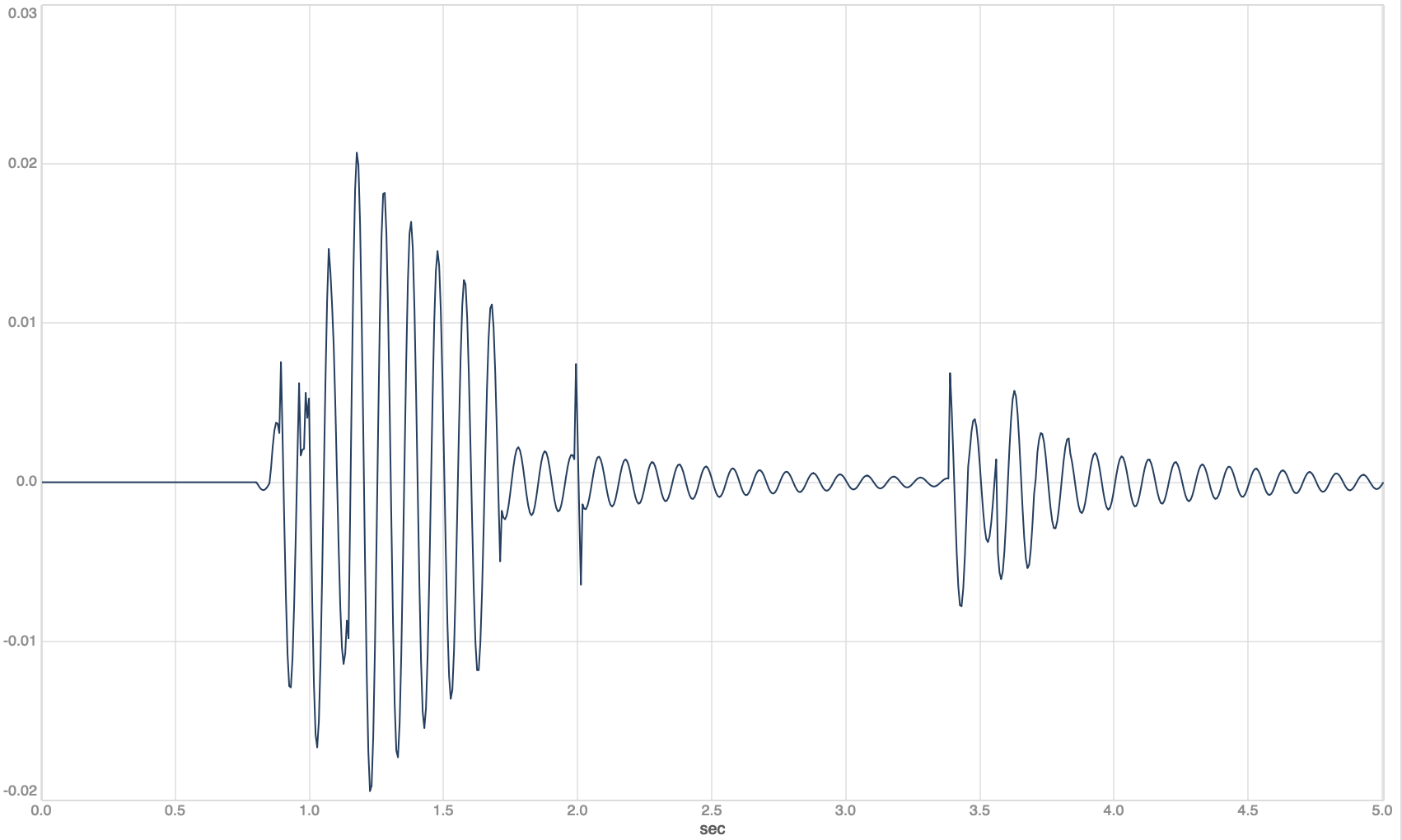
From this result, it is clear to see that the application of first one, then an additional two lines of force to results in a quite dramatically different surface (by analogy). Because of the state of flux of one of the lines of force, showing the same plot again (but separated by time) yields a different surface, showing the affect of that particular line of force on the momentary, but also larger structural unit.
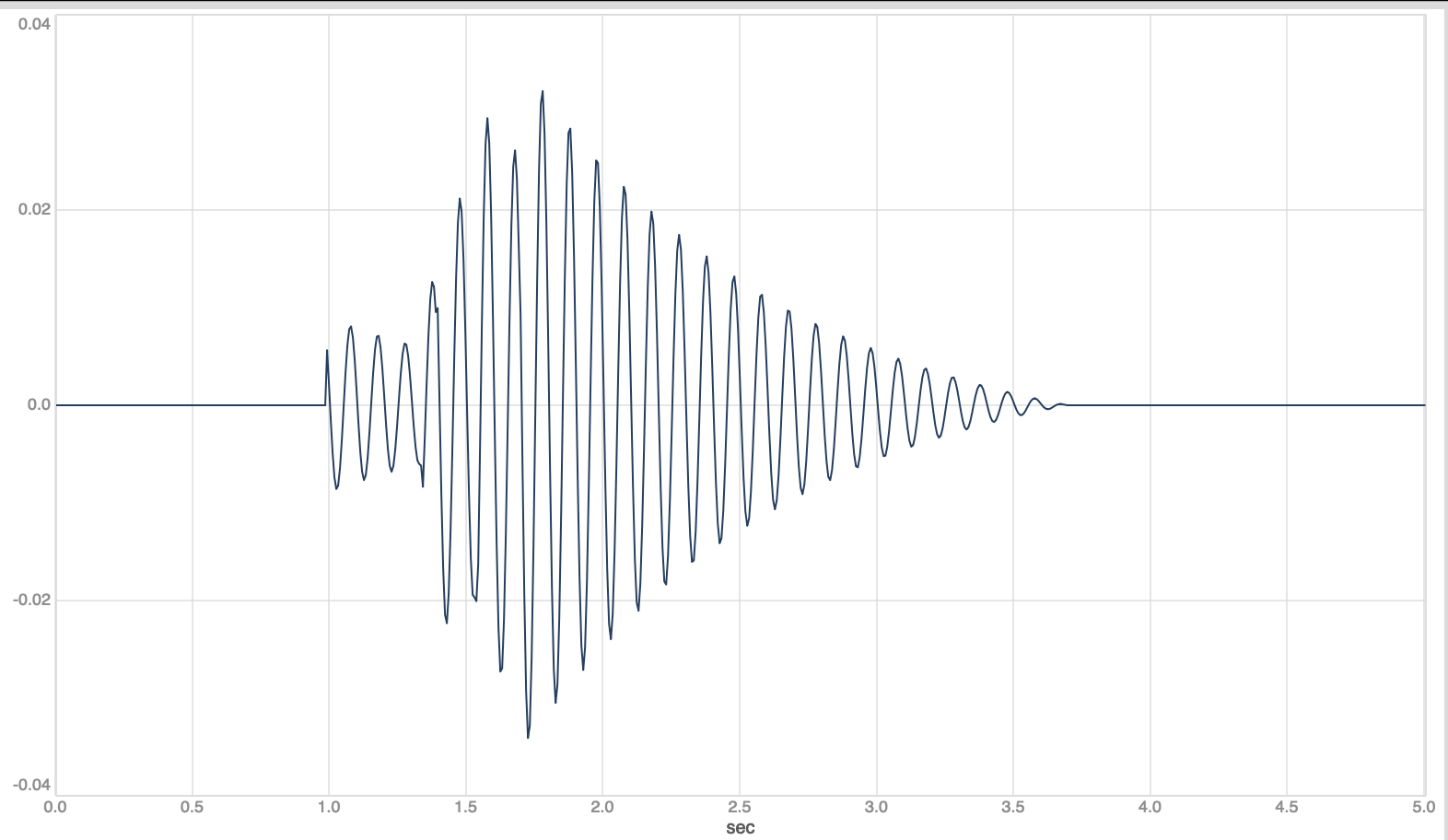
This analogy shows somewhat my original conceptualisation of this phenomena, as a surface that is emergent based on underlying processes. A clear musical example is found in Messiaen’s Quatour pour la fin du temps4 in the first movement, where in the piano part, there are n pitch aggregates that make up the harmonic rhythm, and there are n durations that make up the rhythm-proper. The interaction of these two sets of materials create a variable musical surface as each duration and pitch aggregate sounds together, but because they are unequal in quantity, an instability is produced in the interactions at a structural level in the piano part. It is unclear, however, what the affect on the other parts – the intersections – both in the moment of interaction between lines of force, and in how these affect the piece as a whole. Again, to make an analogy using waves, if one were to drop a rock into a pool, then you see the splash and the outward ripples that eventually turn still. What one doesn’t see is the impact that the rock has both in the moment, as it moves beneath the surface of the water, nor longer-term.
The image below is a still from the anime series Neon Genesis Evangelion. I couldn’t find a complete animation, but I think the visual shows this kind of contradirectional warping in a way that illustrates what I’m trying to get at. Each line of force has potential energy, which impacts the other lines of force around it in ways that are both localised and also have implications for the longer form of the piece.
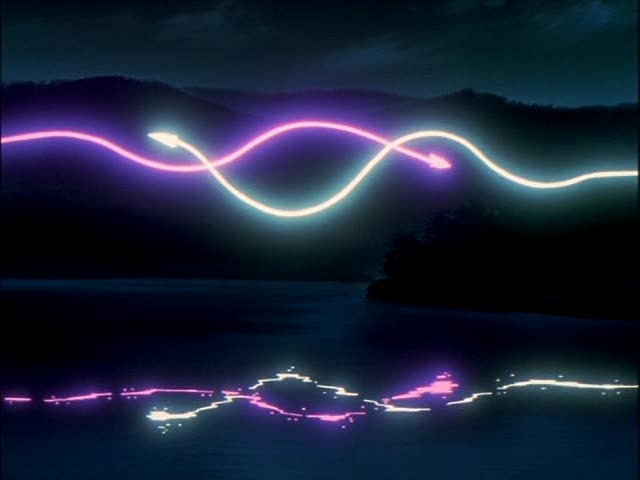
This is an attempt by DALL-E to visualise what I am describing. Feeding the whole text to this point into it generated something that I think actually does visualise the idea somewhat, though in a very AI-ish way, and with the limitation of not being able to see the movement over time. Still, interesting.
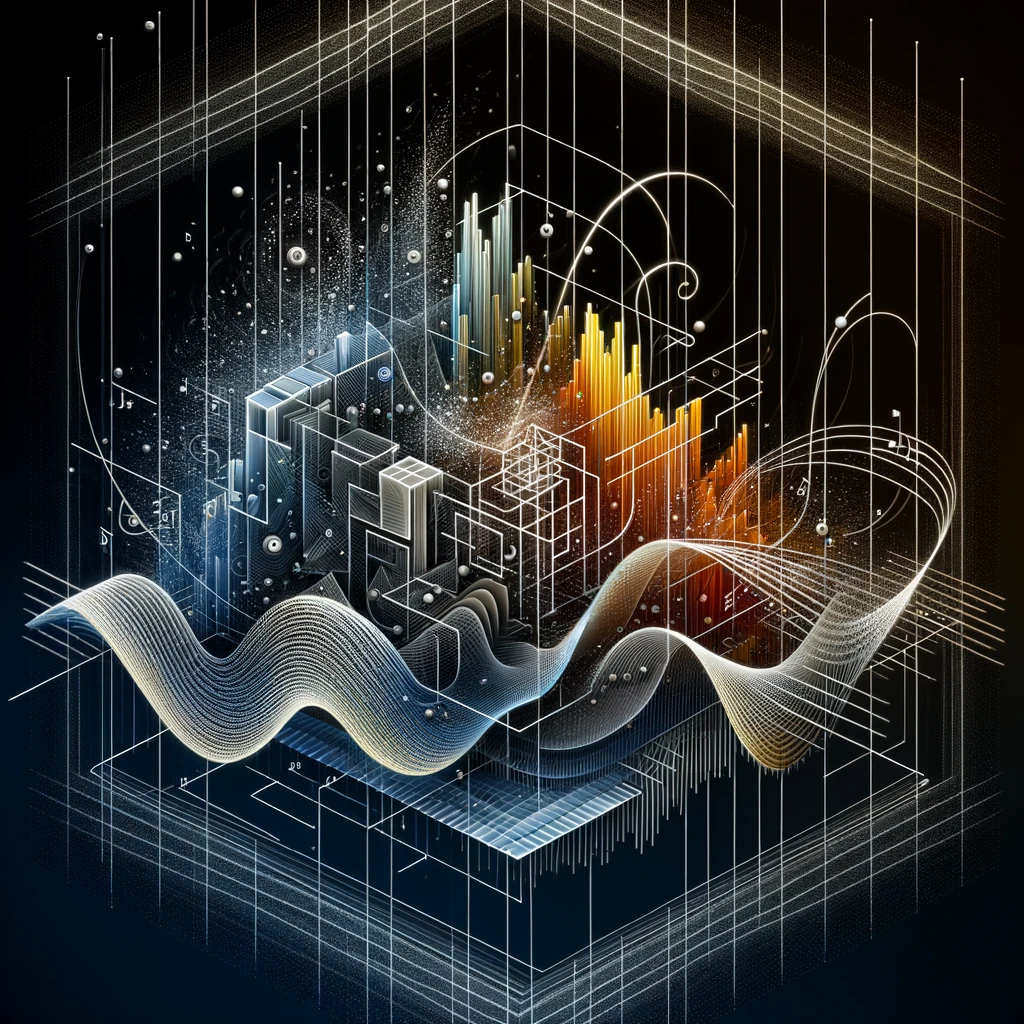
As I continue to interpret and understand the concept of lines of force, I’m not interested in removing my original polyformal concept and replacing it, but rather integrating the lines of force into that mode of thinking. In particular, the local and global impact of the intersections or interactions of the lines of force. While I can imagine how this works, it is a very mentally challenging idea to play with. In principle, applying the lines of force should yield an emergent form derived from the multiple layers of activity that exist beneath it.
Present Work in Progress Implementation
The short study piece-in-progress, and the associated description, shows an attempt toward consolidating these ideas into practice, for application to larger-scale works either in progress or in the future.
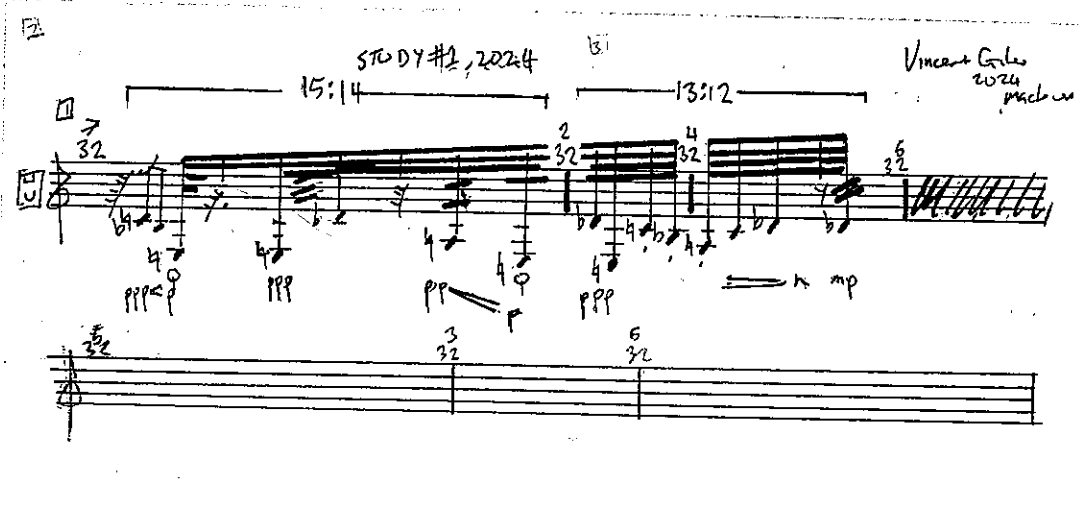
While the above is currently only three measures long, it will be discussed relative to the larger schematic shown below. In comparison to some earlier works where the vast majority of musical data is generated in precomposition, and then ‘refined’ or cut away to reveal the more essential nature of the materials, akin to sculpting (silver as catalyst in organic reactions, The 65th Day, A Semblance of a Whole (a), for example), this short study piece sets out various processes that leave significant room for ‘how’ they are applied and what happens with their intersection, and also with freedom to deviate away from the implied pattern. For example, there is an additive metric container cycle consisting of the metres: 7, 2, 4, 5, 3, 6 (all in 32nd note denominators, a total of 6 objects). This pattern is itself derived from the additive duration cycle that is again based on 32nd notes, that runs: 2, 4, 6, 3, 5, 7, 2.5, 7.5, 3.5 (a total of 9 objects). The metre cycle is a permutation of the integer values from this list. The next line of force is a list of numbers pairs descending from 15 to 6, which suggests some additional pairings internally. Notated as tuples, these are (15, 14), (13, 12), (11, 10), (9, 8), (7, 6). But further iterations can include alternating pairs, such as (15, 13), (14, 12), etc. These ratios are to be superimposed against the quantity of impulses to produce a layer of rhythmic ‘friction’ at the surface. The 15:14 works well against the 7/32 metre, but the 13:12 is stretched across two measures. These tuplets provide a ‘base grid’ against which the duration line can be mapped. But, an interesting interpretation of the duration points is as an ‘onset’ point, whereby some kind of phrase or gesture begins. This is immediately subverted as the initial duration of “2” begins with a rest, with only the second half of the 2 being articulated, and with the space between being filled with two grace-notes. I’ll return to this in a little, because it brings to the fore some lines of force that I had not really considered until now. The onset point description also raises an interesting interpretation in that the 2.5, 7.5, and 3.5 values could be subverted to produce an additional layer tuplet, for example, where the 2.5 duration begins could instead of being 2.5 32nd note sin length, could be 5:4 64th notes instead, producing a nested (and in this case, cross-tuplet) durational layer and therefore increasing the rhythmic ‘friction’ that is established by the already existing tuplets. This is not in the example above, but is a planned interpretation. The final three interconnected lines include dynamics, register, and pitch. The clarinet is divided loosely into its octave-based ranges, but each octave has a different, but complimentary set of pitches available to it. The register movement is plotted per measure, for simplicity given the short length of the piece, but of course by implication this could be mapped out for much longer durations, or could indeed apply to some permuted counterline of the duration cycle, or any number of other collisions.
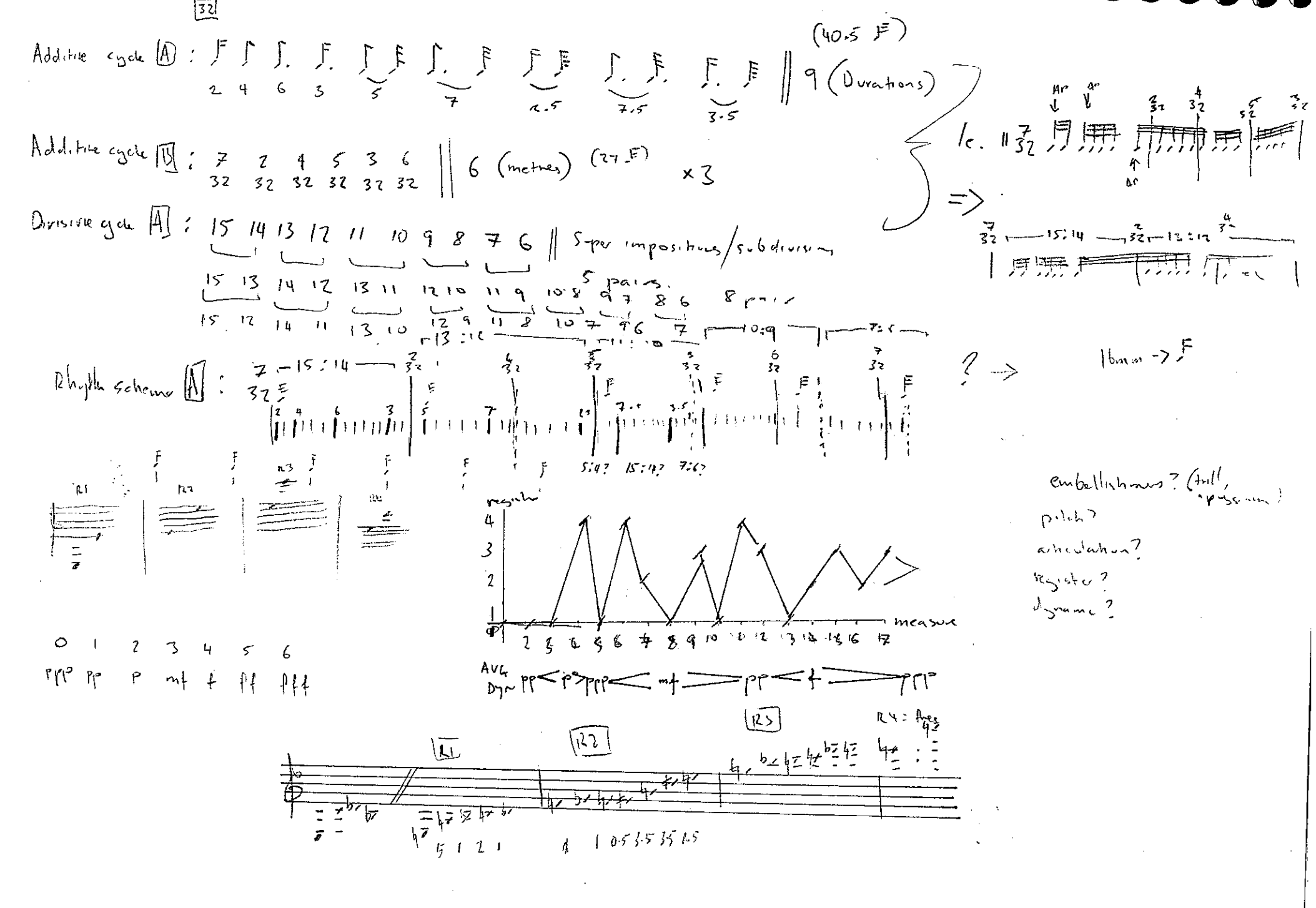
Returning to what are for me newly discovered lines of force, even in the context of this short essay, I realised that part of the power of this kind of technique is the intuitive composer - me - reacting with and against these lines of force, subverting their power, halting it, or redirecting it somewhere else. This is also an interpretive force, where with the schema that I have set up, a willingness to morph the implicit direction of the line into something new, or adjacent, but still in line with the source energy. This interpretive force would also apply at the point of performance, where any performer (or performers in the case of more than one player) is negotiating all of these lines of force, including the spectre of the composer, and adding their own to it. Trying to reveal with fidelity the aural image of the work to the best of their ability.
To bring this back to the introduction, this approach, I think, augments, but differs, from earlier thinking about a music made up for multiple forms. It’s less stringently adhered to, due to the additional line of force that is the composer themself, and examines the form still as an emergent phenomena, but something tactile that shifts and changes as the lines of force interact in a way that is not static and predefined, but active and in flux up until the last moment when the piece is completed.
Ferneyhough B. (1995). Collected writings. Harwood Academic. ↩︎ ↩︎
Toop, R. (1994). “Prima le Parole…” (On the Sketches for Ferneyhough’s Carceri D’invenzione I-III). Perspectives of New Music, 32(1), 154–175. https://doi.org/10.2307/833160 ↩︎
Toop, R. (1990). Brian Ferneyhough’s Lemma-Icon-Epigram. Perspectives of New Music, 28(2), 52–100. https://doi.org/10.2307/833008 ↩︎
Messiaen, Olivier (1942). Quatuor pour la fin du temps : Violon, clarinette en si bemol, violoncello et piano. Durand, Paris ↩︎